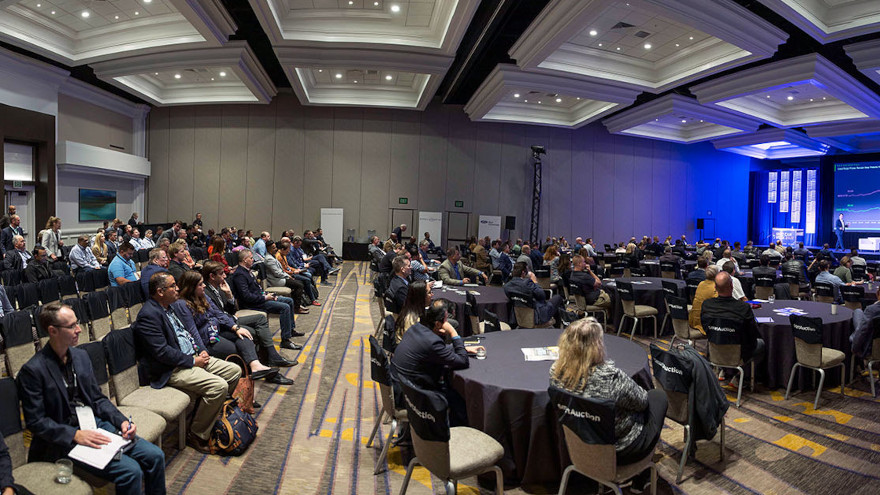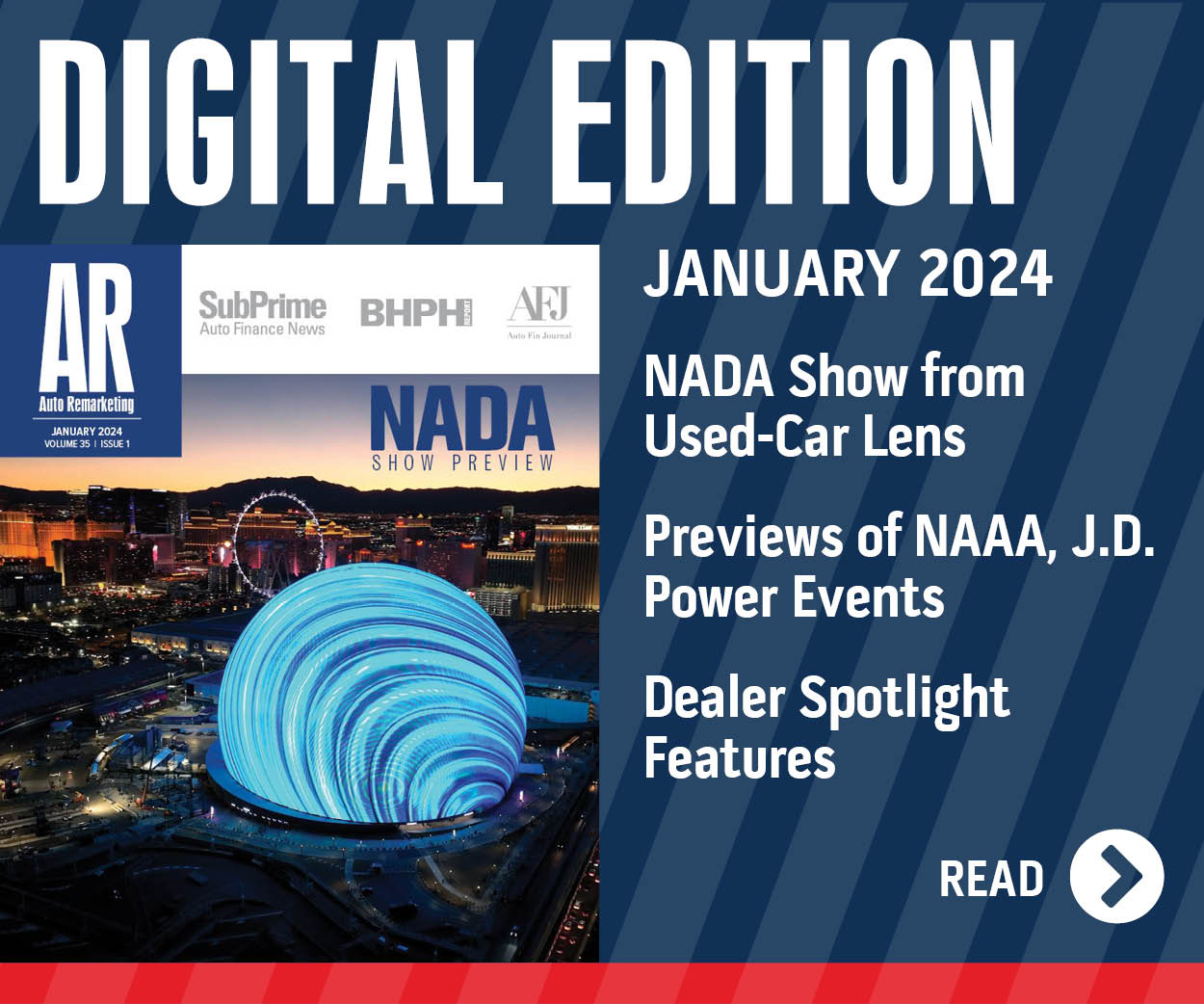COMMENTARY: Breath mints, sneakers and other truths about trade show strategy

Are you ready for this fall's trade shows, like Used Car Week (pictured below)? Jennifer Sanford gets you prepared with this guest column. Photo by Jonathan Fredin.
Trade show season is here. Actually, in automotive, it never goes away.
Starting with NADA Show, our weeks are filled with conferences, expos, 20 groups, and training opportunities all year long. For leaders, it can be a bit overwhelming to find the right events for your business and organize the optimal participation plan.
After years of planning and attending events, I have hundreds of checklists and plans for events large and small. In the end, they all boil down to five major categories of decisions that your marketing leader must address with your executive leadership team.
Top five trade show planning categories:
1) Get started by setting goals.
Every event is different, so you want to plan for each event on its own merit. You can have multiple goals for each event, but it is best to stick with no more than three goals. Are you trying to get new leads and business? Maybe close working deals onsite?
Are you launching a new product? Your event goals will impact your planning and decisions: Should you conduct pre-show marketing, have a booth or other onsite activities, submit to speak at the event? The most common goals are around securing new business, closing working business, meeting new partners, extending your brand and cultivating new relationships.
2) Create a plan for each event.
Your plan must start with a budget. Once you know how much money you can spend, you can formulate your strategy. It is likely that you set an annual budget for events, and now you’re determining how you can accomplish the goals with the money you have set aside for each event. Items you will need to consider include:
— Cost of exhibiting and/or participation: This is usually a booth space, but sometimes participation or sponsorship includes customizable online listings, promotional item distribution, ad space, or even speaking opportunities. Make sure you understand what is included and how to prepare for each item.
— Promotion cost: This includes the cost of doing any pre-show promotion, from traditional advertising to targeted SEM. Keep in mind that you should not rely on the event organizer to get the word to your prospects that you will be at this event. Plan to create your own customer-facing communication.
— Booth cost: If you have a booth, you will need to design something for the space. There are many options from basic table cloths and signage to rental and even purchased booths.
— Personnel costs: This will be your most expensive line item. From airlines to hotels to meals, be prepared to spend up to $2000 per person depending on the city, timeframe and the travel needs of your staff. Client hospitality and entertainment will add more expense to your budget.
— Hidden costs: No matter how well you plan, there will be unanticipated expenses. Maybe your collateral doesn’t arrive and you need to print it at a local printer. Maybe you want to provide your staff with materials or customized attire (or breath mints and Tylenol). Some of the most commonly overlooked items by planners include fees from hotels and venues to handle shipments, hotel resort and internet fees, additional ticket fees for your staff to attend the event, and onsite transportation, like Ubers and taxis needed between venues.
3) Promote your participation.
Consider each event to be like hosting a party. If you want people to visit your booth, you must send them an invitation. Pre-show promotion is just that: an invitation. Your promotion will be dependent on your goals. If you want to drum up more leads, you may choose to use paid advertising and public relations to announce a new product or partnership at the event.
If you want to close business that is already in the funnel, you may focus on email and direct mail to your prospects and customers. Most companies use a combination of media options. Event sponsors will even provide free or heavily discounted tickets to encourage you to bring more prospects to the event. Some of the most common forms of pre-promotion include posting your entire event schedule on your website, using email and direct mail to target prospects and customers, creating socialmedia posts, using traditional print or targeted digital marketing, and even extending the message through sales collateral.
4) Show up with style.
Customize your onsite presence to reflect your goals. Will you be launching a new product or brand? Do you need to wine and dine existing customers? Do you need a booth at this event? For example, if you plan to close more business at the show, you will definitely need a booth with space for your sales reps to confer with clients, print a contract and process that onsite.
Likewise, if you want to attract more prospects, you may offer a special discount or feature a special guest in your booth. If you have a new product, perhaps you want to hold a press conference. Whatever you do, it is important to continue your promotion throughout the event. Assume that people who are onsite need reminders via email and social media to visit your booth. And, bring breath mints. No one likes to speak with a booth staffer who has coffee breath.
5) Follow up. Follow up. Follow up.
The single biggest mistake companies make is to leave a show and fail to contact the people that they met at the show. And, believe it or not, this happens a lot. After each event, your marketing team must contact each person who came to your booth. Often the event host will provide a list of all event attendees. Use that to send every attendee a post-show promotion.
Sales reps must reach out to everyone they met with personal notes, emails or phone calls. Post-show promotion can include social media photographs of highlights from the event. From a planning perspective, this is the time to track your expenses and identify any new business to compute an ROI. A nice touch from an internal communication standpoint is to send a post-show survey to your show attendees asking them for feedback and ideas for the next event.
These categories offer a starting point to help planners organize and execute expert events — every time. Share with your marketing colleagues and contact me with any questions or observations. (And, ladies, leave those high heels behind. The only people noticing them are saying how extravagant you are for wearing such uncomfortable shoes!)
About the Author: Jennifer Sanford is an experienced SaaS marketing leader passionate about the retail automotive experience. Jennifer is the founder of Sanford Marketing Group, an agency specializing in B2B marketing strategy and project management. Jennifer has headed marketing teams for top automotive technology companies over the last 20 years. She has a closet full of comfortable shoes and boxes of breath mints.

 View The Latest Edition
View The Latest Edition

